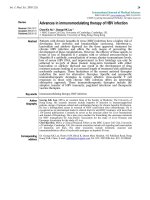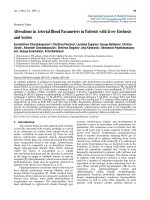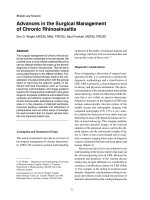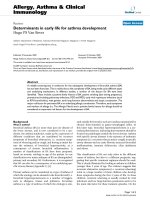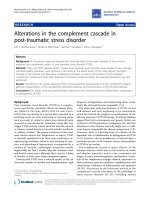Báo cáo y học: "Inotropes in goal-directed therapy: Do we need ‘goals’" ppsx
Bạn đang xem bản rút gọn của tài liệu. Xem và tải ngay bản đầy đủ của tài liệu tại đây (120.64 KB, 2 trang )
Adequate hemodynamic management using well-defi ned
perioperative goal-directed therapy (GDT) is a corner-
stone of tissue perfusion and oxygenation that can
improve outcome. e aim of GDT is to prevent tissue
oxygen debt and energy crisis by maintaining adequate
tissue perfusion and oxygenation in relation to increased
metabolic demand during major surgery.
In an elegant study in the previous issue of Critical
Care, Jhanji and colleagues [1] highlighted the important
pathophysiological mechanisms involved behind the
benefi t of GDT. e authors showed that stroke volume-
targeted colloid administration coupled with a fi xed
infusion rate of dopexamine improved oxygen delivery
(DO
2
), central venous oxygen saturation (ScvO
2
), micro-
vascular blood fl ow, and tissue oxygenation and that fl uid
therapy alone led to additional modest improvements.
ese data echo previous fi ndings that optimizing DO
2
improves outcome [2-5] and that microvascular fl ow
abnormalities could be a key point in determining
postoperative complications following high-risk surgery
[6]. ese results were consistent with those of Lobo and
colleagues [5], who compared the use of fl uids and dobu-
tamine and fl uids alone in high-risk surgical patients. e
use of fl uids and dobutamine to achieve a DO
2
goal (of
greater than 600 mL/min per m
2
) determined better
postoperative outcomes than fl uids alone did.
e study of Jhanji and colleagues, however, raises
several important questions that might deserve future
clinical trials. First, we have to ask whether the hemo-
dynamic optimization should be performed postopera-
tively or, more logically, once the surgical trauma is
induced. In the three study groups, it is clear that baseline
postoperative infl ammatory markers were largely
elevated, rendering the hemodynamic optimiza tion less
able to reduce complications that appear to be present at
a very high rate regardless of the intervention protocol
(between 58% and 69% of the patients). Indeed, several
pieces of evidence suggest that the timing of therapeutic
intervention during GDT could be a critical issue [7], and
most studies predominantly performed GDT starting
intraoperatively [8]. Second, one may question the use of
a fi xed low infusion rate of dopexa mine (0.5 μg/kg per
minute) without targeting any specifi c goals for cardiac
output or DO
2
. Although the use of a low dose of
dopexamine demonstrated benefi ts in terms of survival
and reduction in hospital stay in a previous small-scale
study [9], this was not observed here by Jhanji and
colleagues [1] in this randomized trial on a larger scale.
In the latter context, it seems important to emphasize
that the serum lactate concentration and the base defi cit
remained a bit higher (though not signifi cantly so) during
the fi rst 4 hours of treatment in the fi xed-dose
dopexamine treatment group. erefore, two important
complementary questions remain: Do we need, as for
fl uids, an individualized approach to deliver inotrope
during GDT? What should be the goal to address the
Abstract
There is substantial evidence to demonstrate the
bene ts of goal-directed hemodynamic optimization
using uid loading or inotropic support or both to
improve outcome during major surgery. However, until
now, only limited pathophysiological data have been
available to explain this bene t. The maintenance of
adequate tissue perfusion and global oxygen delivery
is an essential goal for therapy. In an interesting study,
Jhanji and colleagues provided additional data that
emphasize the roles of optimization of intravascular
uid status and low doses of inotropes to improve
microvascular blood ow and tissue oxygenation. This
commentary aims to highlight some issues raised by
this important study and provides additional elements
to further position these results.
© 2010 BioMed Central Ltd
Inotropes in goal-directed therapy: Do we need
‘goals’?
Emmanuel Futier
1
and Benoit Vallet*
2
See related research by Jhanji et al., />COMMENTARY
*Correspondence:
2
Department of Anaesthesiology and Critical Care Medicine, CHU Lille, University
Nord de France, Rue Polonovski, 59037 Lille Cedex France
Full list of author information is available at the end of the article
Futier and Vallet Critical Care 2010, 14:1001
/>© 2010 BioMed Central Ltd
adequacy of inotrope infusion? From an ‘energy debt’
perspective, it is certainly much more important to
consider the DO
2
-to-O
2
consumption (VO
2
)
relationship
than to indicate a specifi c value of DO
2
as a goal [10]. To
this end, Donati and colleagues [7] demonstrated
improved outcome in patients treated with individualized
GDT using fl uids and dobutamine titrated to maintain O
2
extraction (ERO
2
, the ratio of VO
2
to DO
2
) at less than
27% (corresponding approximately to an ScvO
2
of greater
than 73%). An increase in VO
2
without a corresponding
increase in DO
2
, or a decrease in DO
2
and no change in
O
2
requirements, results in an increase in ERO
2
,
rendering ScvO
2
an interesting contributor to patient
monitoring. In critical illness, however, the ability of
tissue to increase ERO
2
might be impaired, and
‘normalized ScvO
2
’ would lose its ability to guide fl uid or
inotrope therapy [11,12]. is constitutes the third
impor tant remaining issue raised by this study: Should
we systematically integrate other markers of cellular
energy adequacy (besides ScvO
2
) such as serum lactate
[12,13], base defi cit, or tissue hypercarbia [14]? In any
case, these markers deserve further investigations in
GDT-based protocols, as has been done in critical illness
such as severe sepsis [12,15], before being considered
eligible tools for high-risk surgery.
In total, we believe it would be more rational to apply
GDT according to individual patients’ targets based on
their specifi c physiological profi le, whether it pertains to
fl uid loading or dopexamine titration. It is obvious that
the use of inotropes should be cautious in patients with
high risk of ischemic cardiovascular events, in which beta
stimulation may be harmful. In a previous study of 122
high-risk patients (81% with an American Society of
Anesthesiologists score of at least 3), Pearse and colleagues
[16] reported a 13% rate of adverse events (tachycardia
and myocardial ischemia) using mean doses of dopexa-
mine of 0.75 μg/kg per minute (interquartile range of 0.5
to 1.0 μg/kg per minute) whereas 24% of patients did not
achieve the DO
2
goal despite receiving the maximum
therapy allowed. Inotrope titration should integrate the
relationship of O
2
needs to the O
2
costs to be delivered.
Finally, we feel that GDT must be applied at the time of
injury (that is, intraoperatively) and not after infl amma-
tion has already started. Such an approach, applied in
further clinical trials, might provide us with responses to
our yet unanswered questions.
Abbreviations
DO
2
, oxygen delivery; ERO
2
, oxygen extraction; GDT, goal-directed therapy;
ScvO
2
, central venous oxygen saturation; VO
2
, oxygen consumption.
Competing interests
The authors declare that they have no competing interests.
Author details
1
Department of Anaesthesiology and Critical Care Medicine, CHU Estaing,
University Hospital of Clermont-Ferrand, 1 place Lucie Aubrac, 63003
Clermont-Ferrand Cedex 1 France.
2
Department of Anaesthesiology and
Critical Care Medicine, CHU Lille, University Nord de France, Rue Polonovski,
59037 Lille Cedex France.
Published: 29 September 2010
References
1. Jhanji S, Vivian-Smith A, Lucena-Amaro S, Watson D, Hinds CJ, Pearse RM:
Haemodynamic optimisation improves tissue microvascular ow and
oxygenation after major surgery: a randomised controlled trial. Crit Care
2010, 14:R151.
2. Boyd O, Grounds RM, Bennett ED: A randomized clinical trial of the e ect of
deliberate perioperative increase of oxygen delivery on mortality in high-
risk surgical patients. JAMA 1993, 270:2699-2707.
3. Wilson J, Woods I, Fawcett J, Whall R, Dibb W, Morris C, McManus E: Reducing
the risk of major elective surgery: randomised controlled trial of
preoperative optimisation of oxygen delivery. BMJ 1999, 318:1099-1103.
4. Kern JW, Shoemaker WC: Meta-analysis of hemodynamic optimization in
high-risk patients. Crit Care Med 2002, 30:1686-1692.
5. Lobo SM, Salgado PF, Castillo VG, Borim AA, Polachini CA, Palchetti JC, Brienzi
SL, de Oliveira GG: E ects of maximizing oxygen delivery on morbidity and
mortality in high-risk surgical patients. Crit Care Med 2000, 28:3396-3404.
6. Jhanji S, Lee C, Watson D, Hinds C, Pearse RM: Microvascular ow and tissue
oxygenation after major abdominal surgery: association with post-
operative complications. Intensive Care Med 2009, 35:671-677.
7. Donati A, Loggi S, Preiser JC, Orsetti G, Munch C, Gabbanelli V, Pelaia P,
Pietropaoli P: Goal-directed intraoperative therapy reduces morbidity and
length of hospital stay in high-risk surgical patients. Chest 2007,
132:1817-1824.
8. Chappell D, Jacob M, Hofmann-Kiefer K, Conzen P, Rehm M: A rational
approach to perioperative uid management. Anesthesiology 2008,
109:723-740.
9. Pearse RM, Belsey JD, Cole JN, Bennett ED: E ect of dopexamine infusion on
mortality following major surgery: individual patient data meta-
regression analysis of published clinical trials. Crit Care Med 2008,
36:1323-1329.
10. Vallet B, Futier E: Perioperative oxygen therapy and oxygen utilization. Curr
Opin Crit Care 2010, 14:359-364.
11. Pope JV, Jones AE, Gaieski DF, Arnold RC, Trzeciak S, Shapiro NI; Emergency
Medicine Shock Research Network (EMShockNet) Investigators: Multicenter
study of central venous oxygen saturation (ScvO(2)) as a predictor of
mortality in patients with sepsis. Ann Emerg Med 2010, 55:40-46.e1.
12. Jones AE, Shapiro NI, Trzeciak S, Arnold RC, Claremont HA, Kline JA: Lactate
clearance vs central venous oxygen saturation as goals of early sepsis
therapy: a randomized clinical trial. JAMA 2010, 303:739-746.
13. Wenkui Y, Ning L, Jianfeng G, Weiqin L, Shaoqiu T, Zhihui T, Tao G, Juanjuan Z,
Fengchan X, Hui S, Weiming Z, Jie-Shou L: Restricted peri-operative uid
administration adjusted by serum lactate level improved outcome after
major elective surgery for gastrointestinal malignancy. Surgery 2010,
147:542-552.
14. Teboul JL, Mercat A, Lenique F, Berton C, Richard C: Value of the venous-
arterial PCO2 gradient to re ect the oxygen supply to demand in humans:
e ects of dobutamine. Crit Care Med 1998, 26:1007-1010.
15. Vallee F, Vallet B, Mathe O, Parraguette J, Mari A, Silva S, Samii K, Fourcade O,
Genestal M: Central venous-to-arterial carbon dioxide di erence:
anadditional target for goal-directed therapy in septic shock? Intensive
Care Med 2008, 34:2218-2225.
16. Pearse R, Dawson D, Fawcett J, Rhodes A, Grounds RM, Bennett ED: Early
goal-directed therapy after major surgery reduces complications and
duration of hospital stay. A randomised, controlled trial
[ISRCTN38797445]. Crit Care 2005, 9:R687-693.
doi:10.1186/cc9251
Cite this article as: Futier E, Vallet B: Inotropes in goal-directed therapy:
Dowe need ‘goals’? Critical Care 2010, 14:1001.
Futier and Vallet Critical Care 2010, 14:1001
/>Page 2 of 2
